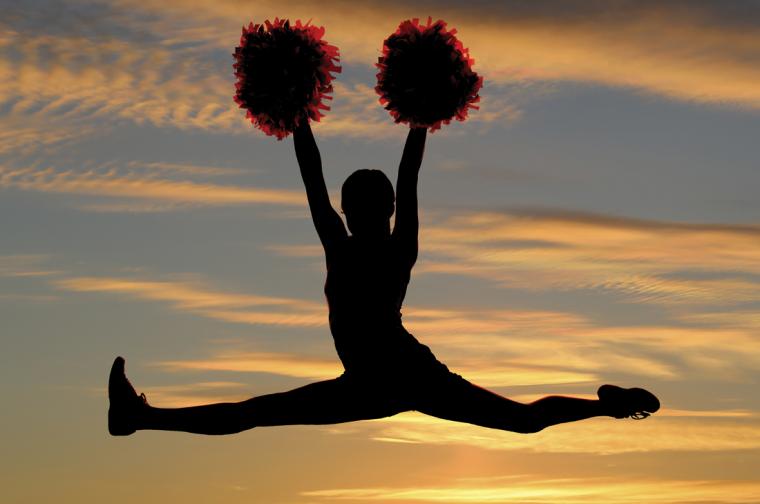
Cheer is finally back with a normal season and a return to pre-pandemic numbers. In fact, we’re seeing a steady increase across all disciplines, including school-based cheer (at all levels and age groups), all-star cheer, pom and STUNT as well as competitive dance (which also has a variety of disciplines). And with more than three million cheerleaders nationwide, the momentum is continuing.
What is the cause of all this growth? Other than pent-up demand (and there certainly was plenty of that), social media has been a big player and an even bigger promotor. Platforms like Facebook Reels and TikTok whetted the public’s appetite for the sport and really drew people in.
Because they are very visual, these platforms gave the sport extra exposure to a new audience. Plus, because complicated stunts and choreography were often showcased on those short videos, people developed a better respect for the athletes, and a better understanding of the sport as a whole. We believe younger athletes were inspired by what they saw – and that they have taken up the sport as a result.
Those videos continue to show up and draw views, particularly since competitions are taking place again. For example, a lot of views came out of the routines performed at the recent ICU (International Cheer Union) world cheerleading championship, held in Orlando at the ESPN Wide World of Sports venue. Game-day videos, with short clips of athletes cheering for their teams, have also been a big hit among viewers.
Great News on STUNT

In May, USA Cheer got word that NCAA Divisions I, II and III will sponsor legislation to add STUNT, a competitive, cheer-based athletic program, as an emerging sport for women. The legislation will be voted on at the January 2023 NCAA convention.
STUNT uses skills found in cheer but does not include the crowd-leading aspect. There are presently 37 programs at the collegiate level. A total of 40 will be needed before STUNT can apply to be a championship sport.
STUNT is actually a very exciting and fast-paced sport to watch. Two teams (generally representing two different colleges) compete head-to-head. Meets are divided into quarters. The first quarter is Partner Stunts, in which teams compete simultaneously on the mat. Group Jumps & Tumbling are performed in the second quarter, and the third quarter consists of Pyramids/Tosses. Each round, the teams compete head to head at the same time on the mat. The fourth quarter is the Team Routine, where teams incorporate the previous three quarters into a team routine.
The team that is judged to have executed the skill best is able to win the round and the point and can determine which routine level will be called next. That means winning a competition depends on both a team’s skill and on its strategy in calling routine levels.
Cheer as a Career Pathway
We are sometimes asked whether college cheerleaders, upon graduation, move on to cheer for NFL teams. It may be that a few do, but more often, we have found that former collegiate cheerleaders stay connected to the sport by coaching. In fact, right now, we have two athletes who cheered for their respective colleges and then, after graduation, went on to represent the USA on our national co-ed squad. They are now married, and both are cheer coaches at the University of Kentucky, which has one of the top programs in the nation. It’s a great example of the way people give back to the sport that has given them so much.
Will Cheer Be in the Olympics?
In 2021, cheer was officially recognized by the International Olympic Committee. We certainly would like to see it showcased in the 2028 Games in Los Angeles – after all, it’s a sport that was born in the USA, although these days, it is contested worldwide.
In the meantime, the USA continues to have tremendous success competing internationally. USA Cheer fields teams that compete represent the country in different divisions. They represent a variety of styles of cheer and dance and compete in the International Cheer Union (ICU) World Championship, FISU and the Pan American Games.
The USA has a long tradition of excellence on the international stage, having won numerous gold medals. This year’s ICU World Championship was finally able to go on, and while not all countries could be present, we had a really nice showing of teams with about 500 athletes representing the United States of America.
The Changing Face of Cheer
Cheer has always been but is becoming even more diverse, particularly here in the USA. Boys and girls, all abilities, all ethnicities, all shapes and sizes are welcome in this sport. We’re also proud to say we have fielded teams in the Adaptive Abilities, Special Abilities and Special Olympics divisions at the ICU World Cheerleading Championships.
The Adaptive Abilities Unified teams (formerly called “ParaCheer”) Special Abilities and the Special Olympics Unified teams offer competitive opportunities for athletes with and without developmental challenges, and the Special Olympics Traditional Teams are comprised of athletes with challenges only.
Facilities for Competition

At the local and state level for high school teams, tournaments might be contested in a gymnasium. For larger state, regional and national meets, as well as those that will have multiple divisions of competition (school, all-star, pom, etc.), larger facilities are needed.
In general, venues to host bigger tournaments require column-free space, a high ceiling and a good sound system, since teams will be bringing their own music (more on this in a minute). Additionally, they will need bleachers for seating (folding bleachers can be brought in if the facility does not have them) and professional lighting. Convention centers as well as indoor arenas are good fits for these kinds of events.
Educating Users on Music
USA Cheer has been working to keep its members compliant with all regulations concerning recorded music that will be played during competitions, and really any cheer performances where music is used. We have a special section of our website devoted to this, and we actively encourage all members to take advantage of it.
Our organization’s educational initiative is intended to provide music producers, coaches, professional members, athletes and spirit leaders with the information needed to help all groups understand U.S. copyright laws regarding music usage as part of performances, routines, competitions, school events, camps, etc. These laws were designed to protect artists, to promote creativity and to ensure that artists are compensated for their creations.
USA Cheer’s initiative was developed out of respect for all artists and to protect our members and all those involved in routines, competitions and performances of any kind in which music is used. In addition, USA Cheer also provides a directory of music providers who have signed an agreement to follow copyright law.
Combines
We are pleased to say that USA Cheer will once again host its combines, allowing high school cheer and STUNT athletes to showcase their skills to college coaches. Overall, we like the fact that our combines might open the door to athletes about colleges they’d never considered before and most importantly, to showcase the vast opportunities that are available to them across the country.
Safety First
USA Cheer is committed to the safety of its athletes, updating its Cheer Rules for all ages and programs: youth, middle school, junior high, high school, college and all-star/club. We also offer a USA Cheer Safety Course as well as a rules course. We recommend all coaches complete the safety course every four years because we want to empower them to make good decisions that keep athletes safe but allow them to retain their ability to challenge themselves.
The pandemic is behind us and cheer, pom and STUNT, as well as competitive dance, are moving ahead. We are excited about the growth we’re seeing and optimistic about the future. SDM

